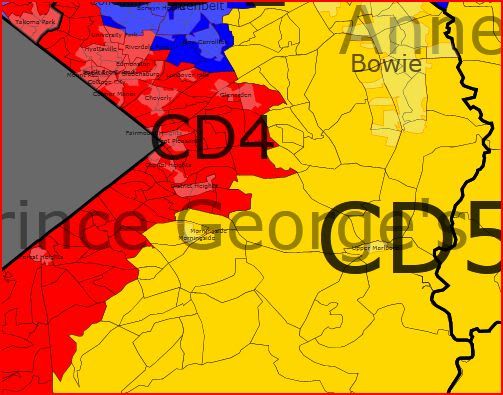I’m finally publishing this; what follows is Answer Guy’s first attempt at redistricting Maryland.
The objectives:
Preserve the two majority-African-American districts, one based in Baltimore, the other in Prince George’s County, per Voting Rights Act requirements. Easy enough.
Give all seven current Democratic incumbents a similar or better chance to win re-election than the current districts allow, especially in the case of MD-01. That means preserving the existing base of each incumbent as much as possible.
Keep communities of interest together as much as possible, if not too inconsistent with the above.
Create districts that avoid the ungainly shapes that many of the current Maryland districts have.
More below the fold…
Map Overview
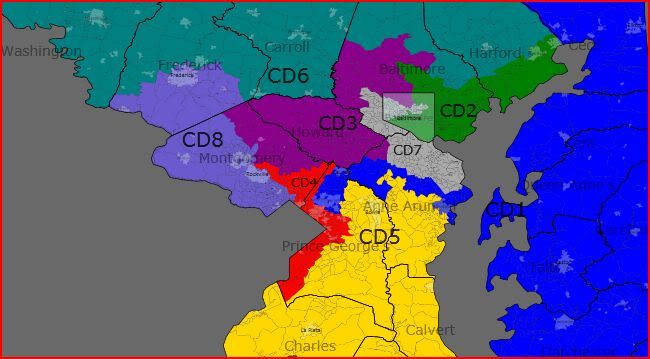
Note: Areas outside this map are in the districts you’d think they’d be in from the context.
First District

Description: All of the Eastern Shore counties – Worcester, Somerset, Wicomico, Dorchester, Talbot, Caroline, Queen Anne’s, Kent, Cecil; portions of Anne Arundel County (Annapolis, Fort Meade, portions of Odenton, East Laurel) and northern portions (Laurel, Beltsville, College Park, Greenbelt, and New Carrollton) of Prince George’s County. Colored dark blue here.
Incumbent: Frank Kratovil (D-Stevensville)
(Note: Likely Republican MD-01 nominee Andrew Harris, who has at least a 50-50 chance of winning this November, doesn’t live anywhere near here, and the areas which supported him the most last time and will again this time aren’t either.)
Map Change: This new MD-01 still includes the entire Eastern Shore of Maryland. But while the current MD-01 includes two chunks of land (one in Baltimore and Harford Counties, the other in Anne Arundel County) very heavy on Republicans; this MD-01 replaces those areas almost entirely (there are a few precincts in Anne Arundel in common) with territory very heavy on Democrats. The Republican areas west of the bridges – which supported McCain in even higher numbers than the Eastern Shore did – got carved up. The Anne Arundel County portion got split, with most of it going to MD-07, but some portions going to MD-05. The Harford and Baltimore County portion got divided three ways, mostly into the new MD-06 but with small portions being picked up by MD-02 and MD-03.
1st District Pop Pct Wh Bl Hisp Asn Oth Oba McC
Shore 437958 62% 79 16 3 1 1 43 55
Anne Arundel 132950 19% 57 29 4 8 2 62 37
Prince George’s 133292 19% 33 43 13 9 2 82 17
Total 704928 66 24 6 3 1 55 44
Old District 662062 86 11 2 1 1 40 58
Projected PVI: D+2
The Good News:
This is the most altered district, and by design, turning a strong Republican district into a Democratic-leaning swing district.
This district is in a sense designed for a guy like Kratovil, who would attempt to simultaneously appeal to swing voters on the Shore to support one of their own and to the Democrats in the rest of the district. The western portion of the current 1st gave John McCain 65% of their votes; the western portion of the new 1st gave Barack Obama 68% of their votes. The Anne Arundel portion is relatively thin, mostly avoiding Republican-heavy areas in the county to reach a highly diverse and heavily Democratic chunk of northern Prince George’s County. Due to VRA compliance requirements for MD-04, this MD-01 contains only a handful of black-majority precincts (in the Landover and New Carrollton areas.) The changes would still more than double the black population of MD-01, and the Hispanic and Asian shares of the electorate also increase dramatically with the inclusion of many diverse Washington suburbs like College Park, Beltsville, Greenbelt, Laurel, and Odenton. . Obama’s 55% showing may overstate the Democratic leanings of this district a bit – though Kratovil was able to run 10 points ahead of the national ticket at the same time, and now most of the areas that backed Harris in that contest have been removed from the district.
It’s not guaranteed not to ever elect a Republican, but it would be very difficult for an arch-conservative of the Club For Growth variety to get elected here.
The Less-Than-Good News:
On the surface, the changes are pretty much all positive for Dems. However…the potential electoral dynamics change dramatically on several levels. Because I also placed a priority on not significantly endangering any of the current Democratic seats, this isn’t a strong enough Democratic electorate to get rid of a Republican who exhibits some measure of cross-party and independent appeal, particularly during a Republican-leaning election cycle. The Eastern Shore, who represent 62% of the new district’s population, still prefers Republicans more often than not, and so do parts of the Anne Arundel County portion of the district. As I said above, the 55% showing for Obama is probably not a new normal and the partisan lean would lose a few points if non-white turnout regresses to levels more commonly seen prior to 2008.
It’s not hard to imagine competitive Democratic primaries that pit moderates against progressives that could produce candidates that either swing voters or base voters might find unappealing. The Democrats of the current MD-01 generally lean conservative, but Democratic candidates in this MD-01 would have contend with a much more varied electorate. Kratovil, especially if he were no longer an incumbent, would almost certainly face a primary challenge from his left of some sort if he were to run here, given his voting record.
The Shore would dominate Republican primaries, due to the lack of registered Republicans in the rest of the new district, to a point the dynamics that produce a candidate like Andy Harris (someone with trouble appealing to Shore residents or to swing voters in general) would be unlikely to materialize. GOP candidates would mostly come from the Shore and might be able to use that to their advantage.
Ironically enough, Wayne Gilchrest almost certainly still be in Congress if he had this map two years ago; there’s no way a wingnut primary challenge would have succeeded, and he’d be tough to dislodge in a general election even in a good year for Democrats across the board like 2008. In a Republican year, it’s not hard to imagine some types of Republican winning here, though a guy like Harris would have no shot, and not just because it doesn’t go anywhere near where he lives.
Fundraising might become a higher priority, as the new district lines cut well into the very expensive Washington media market. To reach the whole district would involve using both Baltimore-based and DC-based media. The current district, by contrast, doesn’t really include much of anything that one might describe as a proper DC suburb.
The Bottom Line:
In a 2012 election with Obama on the ballot, with these lines, though it’s not a slam dunk by any means, I like Team Blue’s chances, whether with Kratovil or with someone else.
Second District
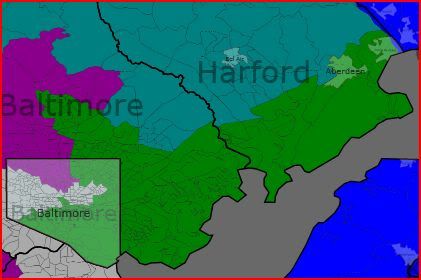
Description: Contains southern portions (Edgewood, Aberdeen, and Havre de Grace) of Harford County; eastern, northeastern, and north-central portions (Dundalk, Essex, Middle River, Parkville, Timonium, and Cockeysville) of Baltimore County; and northeast, east, central, and southern portions of Baltimore City. Colored dark green here.
Incumbent: C.A. Ruppersburger (D-Cockeysville)
(Note: Likely Republican MD-01 nominee Andrew Harris lives here, though most of his State Senate constituents don’t.)
Map Changes:
This new MD-02 has been made much more compact. It no longer contains any portion of Anne Arundel County and doesn’t go west of Cockeysville anymore, saying goodbye to the portions of Owings Mills and Reisterstown currently within its borders. Containing much more of Baltimore City than previous versions of the district did, it’s now the district that includes most of the areas of Baltimore of interest to tourists – Federal Hill, the Inner Harbor/Downtown, Mount Vernon, Bolton Hill, Fells Point, Canton, Greektown, and Highlandtown. It also includes a bigger chunk of Northeast Baltimore than the current version does. The whole of southeastern Baltimore County is still here, and the Harford County portion is very similar (slightly smaller) to what is in the current district.
2nd District Pop Pct Wh Bl Hisp Asn Oth Oba McC
Baltimore City 277202 39% 45 47 4 2 1 82 17
Baltimore County 339213 48% 76 15 4 3 1 48 50
Harford 88267 13% 65 26 4 2 2 55 43
Total 704682 62 29 4 3 1 62 36
Old District 662060 66 27 2 2 1 60 38
Projected PVI: D+9
The Good News:
The addition of central Baltimore is the main reason that the new electorate moves two points to the Democrats, more than making up for the loss of some heavily Democratic northwest suburbs given to MD-03 and MD-07. This district does contain several city neighborhoods in outlying parts in northeast and far eastern Baltimore that are neither particularly liberal nor particularly Democratic, but also contains several mostly black precincts where the Republican share of the vote is in the low single digits.
The Baltimore County portion, about half the district, was carried by McCain, but many state and local Democrats, most notably incumbent Ruppersburger, have outperformed Obama significantly in these areas, particularly the East Side, in a development widely discussed in other SSP diaries about Maryland. And while Harford County as a whole may tilt Republican, the table above shows that the section of it included in MD-02 does not.
The Not-So-Good News:
This district may have been carried by Bob Ehrlich in his gubernatorial race in 2002 and looks more like the district he used to represent in the 1995-2003 period than the current MD-02 does; of the six districts designed to be relatively safe for Democrats, the Republicans have a deeper bench of officeholders at the state and local level than in any of the others. There are signs that the east side of Baltimore County might be trending away from its traditional Democratic lean. Still, it is very hard to imagine even Ehrlich or a Republican who can duplicate his appeal winning in a district where nearly 40% of the constituents are Baltimore City residents.
As a secondary concern, this portion of Baltimore County is home to a lot of conserva-Dems who might be able to install a not-particularly-loyal Democrat into the seat in an open-seat situation if the city vote is either low or split.
The Bottom Line:
Dutch Ruppersburger doesn’t really need the help, but this map gives him some anyway. You never know when a seat is going to become open. From a redrawing point of view, keeping this district out of northwest Baltimore County helped make it and MD-03 much more compact with more appealing shapes without affecting their respective partisan makeups much. It’s a set of communities that hang together pretty well. Should remain in the Democratic column.
Third District
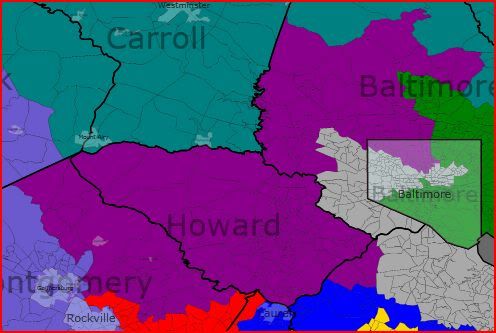
Descriptions: Contains northern and northwest portions of Baltimore City, northern and western portions (Towson, Pikesville, Owings Mills, Reisterstown, Randallstown) of Baltimore County, all of Howard County, northwestern portions (Jessup, Hanover) of Anne Arundel County, and northeastern portions (Damascus, Laytonsville, Olney, Burtonsville) of Montgomery County. Colored purple here.
Incumbent: John Sarbanes (D-Towson)
Map Changes:
These are dramatic changes as well, as the new MD-03 is mostly pushed out of Baltimore (and pushed out of downtown entirely) and Annapolis yet is still made more Democratic, mostly by adding new territory in the west via moving more into Washington suburbs.
The seemingly arbitrary pockets of East Baltimore are gone; what remains is more cohesive and more easily definable set of northern and northwestern city neighborhoods. Roughly from east to west, they are Waverly, Charles Village, Guilford, Homeland, Roland Park, Hampden, Mt. Washington, and upper portions of Park Heights; most are predominantly white (Park Heights and Waverly are mostly black while Charles Village is one of the most integrated parts of Baltimore) and relatively liberal.
The Baltimore County portion does contain some conservative exurban areas in northern Baltimore County (Sparks and Pheonix areas) but is concentrated mostly in more urban Towson and Pikesville. Some precincts to the west and northwest of Baltimore are instead in the black-majority MD-07, but this portion of MD-03 does contain some majority-black precincts. The Arbutus/Halethorpe/Landsdowne area in southern Baltimore County has been removed.
Howard County, previously split with MD-07, is now included in its entirety.
A small portion of Anne Arundel County does remain, but it now goes nowhere near Annapolis, instead staying close to the B-W Parkway.
The addition that sticks out most is the new territory in Montgomery County, about 130K residents, mostly outer suburbanites. There are a few precincts that carry Silver Spring, Rockville or Gaithersburg addresses, but this MD-03 contains none of either of the cities of Rockville or Gaithersburg, and nothing particularly close to the core of Silver Spring, as everything here is well outside the Beltway.
Things had to change for several reasons. One is that the population distribution in the state is shifting away from Greater Baltimore in general and Baltimore City in particular and some district based in or around Baltimore was inevitably going to end up with more Washington suburbanites. Another is that to fix the hideous shapes of some of the current districts required cutting off some of the more ungainly-looking appendages. The current MD-03 is a group of pockets joined together by a series of thin strands and cleaning that up required shedding some of the pockets and filling out others; the threads running to the east were incompatible with the rest of the plan for the state, so the only direction to go was to the west.
3rd District Pop Pct Wh Bl Hisp Asn Oth Oba McC
Baltimore City 92372 13% 61 29 3 5 1 81 17
Baltimore County 193424 27% 66 24 3 5 1 59 39
Howard/Arundel (Balt. Area) 167389 24% 63 18 5 12 2 59 39
Howard West (DC Area) 120254 17% 64 17 5 11 2 63 35
Montgomery 131144 19% 64 15 9 10 2 62 37
Total 704583 64 20 5 9 2 63 36
Old District 662062 77 16 3 3 1 59 39
Projected PVI: D+10
The Not-So-Good News:
It’s often awkward when redistricting changes a constituency this much, even if in the abstract the changes are favorable to an incumbent seeking re-election, as they are here. At some level, this would be like an open-seat race as far as about half the electorate is concerned. It might even be more awkward than usual in this case. The table lists the different components of the district; I divided Howard County into areas likely have some connection to Baltimore (roughly anything north of Route 32 and east of Route 29) and those areas unlikely to know much about Baltimore and its politics. Throw the latter in with MoCo and that’s about 36% of the district that has no Baltimore connection. Reaching them would require investing in an expensive new media market. (Though there are already probably some residents of the current MD-03 who are better reached via Washington media than Baltimore media because Washington casts a much bigger shadow.) Incumbent John Sarbanes lives in Towson in Baltimore County and his family is based in Baltimore; though his name is well-known in the western portions of the new MD-03, he himself is not.
The Good News:
From Democrats’ point of view, simply put, what could have become a potential swing district in a year with low Baltimore City turnout is made four points more Democratic. These new constituents aren’t likely to vote Republican, especially compared with what else could have been placed in this district. The Republican bench here is almost entirely confined to two areas, one in western Howard County, the other in northern Baltimore County, that have little in common with the rest of the district. The main bases of the district since the ’90s have been north Baltimore, Towson, Pikesville, and Columbia, and they’re all still here.
From Baltimore’s point of view, this is a district that even in an open-seat Democratic primary or general election is still more likely to choose a Baltimore-area representative than one from closer to DC; not only do most residents of the district live closer to Baltimore, but the DC-focused areas contain large numbers of new, less-established residents with no ties to existing political cliques. (Obviously, this isn’t good news for Montgomery County’s clout, but they’d they have no less than now.)
From Sarbanes’ own point of view, these new areas, in addition to not being of much help to future Republican opponents, aren’t especially likely to form the base for any successful region-based (notenough of them) or ideology-based (not different enough from the rest of the district to matter) primary challenges. And any Baltimore-area politician, looking at a future statewide run is going to need to be known in MoCo.
Bottom Line:
This district should be safe for John Sarbanes and is unlikely to be in danger of flipping to the Republicans should he decide to move on.
Fourth District
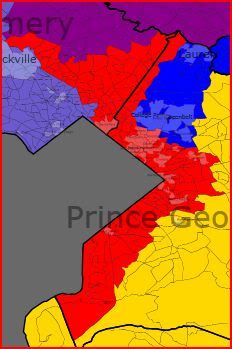
Description: Portions of Prince George’s County (Ft. Washington, Oxon Hill, District Heights, Capitol Heights, Glenarden, Cheverly, Hyattsville, Langley Park) close to Washington, DC, and eastern and central portions (Takoma Park, East Silver Spring, Wheaton, White Oak, Burtonsville) of Montgomery County. Colored red here.
Incumbent: Donna Edwards (D-Fort Washington)
Map Change: This MD-04 sheds some Upper Montgomery territory to the expansion of MD-03, and cedes some of central and southern Prince George’s to MD-05. It picks up more of close-in eastern Montgomery County from MD-08 for the sake of compactness.
4th District Pop Pct Wh Bl Hisp Asn Oth Oba McC
Prince George’s 435116 62% 8 70 18 3 1 93 6
Montgomery 268281 38% 38 25 21 14 2 77 21
Total 703397 20 53 19 7 2 87 12
Old District 662062 27 57 8 6 0 85 14
Projected PVI: D+32
The Good News: This version of MD-04 is even more strongly Democratic (despite reducing the African-American share of the residents from 57% to 53%) which ranks it among the most Democratic and most liberal districts in the nation. I did not set out to strengthen the Democratic lean here, it’s a natural consequence of removing less Democratic far-flung areas like Clarksburg and making things more compact and leaving room for the MD-03 shift chronicled above. It’s interesting from a political-demography perspective; it’s not every day you can change a district’s borders to include fewer African-Americans and yet increase the Democratic share of the vote. From Edwards; perspective, the increase in the Democratic vote in Montgomery also has the effect of making a Prince George’s County-based primary challenge tougher.
The Not-So-Good News: There are no Republican-leaning areas anywhere near here to neutralize, unless one wants push these borders way south to break up Southern Maryland or way north to get some less Democratic parts of Montgomery or Howard Counties, and I had good reasons not to do either.
Fifth District
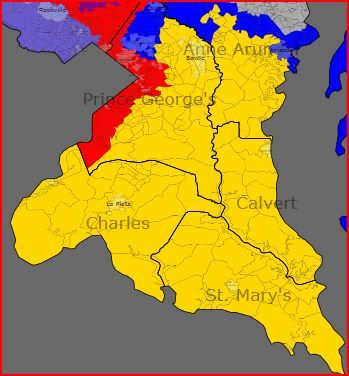
Description: Southern and central portions (Crofton, Millersville, Davidsonville, Edgewater, Deale) of Anne Arundel County; central, western and southern portions (Bowie, Seabrook, Largo, Mitchellville, Forestville, Upper Marlboro, Brandywine, Acokeek) of Prince George’s County; all of Charles County; all of Calvert County; all of St. Mary’s County. Colored yellow here.
Incumbent: Steny Hoyer (D-Mechanicsville)
Projected PVI: D+12
Map Change: Less than many districts. The new MD-05 is changed mostly to help MD-01, shedding areas in northern Prince George’s County (such as Laurel, Greenbelt, and College Park) and western and central Anne Arundel County. It doesn’t weaken as a strong Democratic district due its new areas in central Prince George’s County left behind by MD-04, a change reflected in the demographics numbers as the proportion of African-Americans increases from 30% to 36%.
5th District
Anne Arundel 120226 17% 84 9 3 2 1 45 54
Prince George’s 252444 36% 25 65 5 3 2 87 12
Charles 140764 20% 52 39 4 2 2 64 35
St. Mary’s/Calvert 190276 27% 79 15 3 2 2 45 54
Total 703710 55 36 4 3 2 66 33
Old District 662060 60 30 4 4 0 65 33
The Good News:
A reasonably safe Democratic district (at least by 2008 metrics) moves one more point in that direction. Southern Maryland is kept together as a unit. From a pro-diversity point of view, an African-American would have a decent shot in an open seat Democratic primary here, more so than the currently existing MD-05. Though there is a reasonable Republican farm team in this district, it would be very hard to overcome the Democratic bloc vote in Prince George’s, especially as Charles County heads in a similar direction.
The Not-So-Good News:
Hoyer and the Democrats, though they still doesn’t have much reason to worry, are now slightly more dependent on the African-American vote in MD-05, meaning that a lower turnout model would move this district closer to the new MD-02 or MD-03 in partisan breakdown rather than a truly safe-in-all-circumstances seat. This would be one of the best places in the nation for a black Republican to launch a political career.
Our Majority Leader should be fine here, and whenever the day comes, his Democratic successor here should be as well.
Sixth District

Description: All of Garrett, Allegany, and Washington Counties; western, northern, and eastern portions (Middletown, Thurmont, Walkersville) of Frederick County; all of Carroll County; far northern (Upperco, Parkton) and northeastern (Perry Hall, Baldwin) portions of Baltimore County; central and northern portions (Joppa, Bel Air, Jarrettsville, Pylesville) of Harford County. Colored teal blue here.
The Incumbent: Roscoe Bartlett (R-Frederick)
(Note: Republican MD-01 nominee Andrew Harris doesn’t live here, but most of his current State Senate district is in here, and so are the areas of MD-01 who supported him the most last time and will again this time.)
Map Changes:
It’s pretty obvious what happens here. The small portion of Montgomery County (mostly Damascus) is handed off to MD-03. The City of Frederick and its immediate environs, plus the area around Brunswick, are given to MD-08. The Reistertown area is now in MD-03. In exchange, the new MD-06 picks up a bunch of areas from the former MD-01, in northeastern Baltimore County and central Harford County. In partisan terms, most of the few areas left in MD-06 that were favorable, or even neutral, to Democrats are gone; all but one of the precincts in this district carried by Obama are in Hagerstown, the sole exception being a precinct in Cumberland that Obama carried by five votes.
6th District Pop Pct Wh Bl Hisp Asn Oth Oba McC
Western Maryland 320515 89 6 2 1 1 38 60
Baltimore Exurban 383311 91 4 2 2 1 33 65
Total 703826 90 5 2 2 1 35 63
Old District 662060 92 5 1 1 0 40 58
Projected PVI: R+18
The Good News:
There are seven Democrats in an eight-member delegation. None of them have to run in this district or any portion of it. (It was not a goal of mine to make Bartlett move.)
On the upside, there could be some entertainment value the next time this seat opens up (Bartlett is no spring chicken) as the various GOP aspirants each try to out-wingnut each other. The only other real subject of potential interest is seeing if a Western Marylander can gain traction in a district where denizens of Baltimore exurbs are more numerous.
The Not-So-Good News:
There are still enough Republicans, and areas full of them, in Maryland to command one district. Here it is.
More seriously, one consequence of generating a district like this is that Democrats, independents, and liberal-to-moderate voters in general have very little say in who gets elected to represent this district. While that’s good for the Democrats, both nationwide and in Maryland, in some sense – anyone who can survive a GOP primary in this electorate has slim chances of developing the sort of cross-party appeal a Republican would need to win statewide, and we’re talking about a state GOP that’s already skilled at cutting off its nose to spite its own face here – it’s bad from a good-government perspective. Competitive races are good for many governmental functions, and I know that exercises like this one that go on in state capitals coast-to-coast tend to make such contests less likely.
But there’s no way I’m going to unilaterally disarm.
Bottom Line: Safe Republican; not much else to say.
Seventh District

Description: Portions of east-central and western Baltimore City; western and southwestern portions (Lochearn, Woodlawn, Catonsville, Arbutus, Halethorpe) of Baltimore County; north-central and northeastern (Brooklyn Park, Linthicum, Severn, Glen Burnie, Pasadena, Arnold, Severna Park) portions of Anne Arundel County. Colored medium gray here.
Incumbent: Elijah Cummings (D-Baltimore)
Map Changes:
There’s a little less of Baltimore here now, MD-02 in particular grabbing a larger share; what remains is two clusters of heavily black neighborhoods (the East Baltimore is section centered just north of Johns Hopkins Hospital; the larger West Baltimore section expands westward from Druid Hill Park, and follows Reisterstown Road, Liberty Heights Avenue, Route 40, and Frederick Avenue outwards) joined by a narrow neck around where North Avenue meets Interstate 83. 95% of its votes went to Obama. Though there are some pockets of stable middle-class neighborhoods to be found here, the majority of these neighborhoods are beset by longstanding issues of poverty, crime, and urban blight.
The Baltimore County portion includes most of the majority-black suburbs to the west of Baltimore proper. The new version contracts slightly in the Interstate 70 area but expands towards Randallstown out Liberty Road. It now includes all of Catonsville and inherits the southwest corner of Baltimore County from MD-03. All in all, the Baltimore County portion of MD-07 is about evenly split between blacks and whites.
The Anne Arundel portion is inherited from MD-01, MD-02, and MD-03, and is designed to sop out Republican areas formerly assigned to those districts. Collectively, it gave 55% of its votes to John McCain.
7th District Pop Pct Wh Bl Hisp Asn Oth Oba McC
Baltimore City 267345 38% 6 91 1 1 1 95 5
Baltimore County 191107 27% 42 49 3 4 2 73 25
Anne Arundel 246238 35% 82 10 3 3 2 43 55
Total 704690 42 51 2 3 1 69 30
Old 662060 35 59 2 4 1 79 20
Projected PVI: D+15
The Good News:
Fewer wasted Democratic votes. Of the seven Democrats in the delegation, only Donna Edwards in MD-04 needed less help. It’s still VRA compliant.
As I explain below, Cummings isn’t going to be pleased. However, if he harbors statewide ambitions, introducing himself to Democrats in northern Anne Arundel County might help him emerge from what could be a crowded primary field.
The Not-So-Good News:
Democrats are 10 points weaker here now, for three reasons – the new MD-07 has a smaller share of Baltimore City (mostly shedding racially mixed or mostly white areas with liberals more needed elsewhere), a lower percentage of African-Americans (from 59% to 51%), and a shift in suburban population from [relatively] Democrat-family portions of Howard County to more Republican-leaning portions of Anne Arundel County. There’s a bit of a polarized electorate here; you can draw a line through Baltimore County on Route 40 and then follow the southern border of Baltimore City and you’ll discover mostly black Democratic voters on the north side of the line and mostly white Republican voters on the south side. What keeps the district out of the swing category despite this is that the few exceptions to the rule – Brooklyn Park and Severn have sizable African-American populations, and Democrats do fairly well in Catonsville – are all on the southern side of the divide.
Incumbent Eli Cummings will likely not be a happy camper, though he probably doesn’t have much to worry about. He’d have to introduce himself to a whole new set (about 40% of this district is brand new) of constituents, many of whom are strongly inclined to support his Republican opponents. It’ll be easier to recruit Republican challengers from Anne Arundel than from any area he now represents. If an African-American could somehow emerge from a Republican congressional primary, he’d have a better chance here than in most places.
But this district still gave Obama 69% of its votes; even if that’s a vote ceiling, any GOP candidate would need to run double-digits ahead of the national ticket to even have a shot, and rare is the candidate that can accomplish such a feat, even in an open seat situation.
Bottom Line:
This seat’s been weakened (by necessity) quite a bit but still isn’t going to show up on any GOP potential pickup lists anytime soon, with or without Cummings.
Eighth District

Description: Southern, central, and western portions (Silver Spring, Kensington, Chevy Chase, Bethesda, Potomac, Rockville, Gaithersburg, Germantown, Clarksburg, Poolesville) of Montgomery County; southern and central portions (Frederick City, Urbana, Brunswick) of Frederick County. Colored lavender here.
Incumbent: Chris Van Hollen (D-Kensington)
Map Changes:
MD-08 moves out of Prince George’s County and cedes a large chunk of eastern Montgomery County (Takoma Park, parts of Sliver Spring, Wheaton, White Oak) to MD-04. In exchange MD-08 moves up into Frederick County, taking the City of Frederick and its environs from MD-06. The result is a less Democratic but still safe district.
8th District
Montgomery 551255 78% 59 11 13 14 2 71 27
Frederick 152526 22% 74 12 8 5 2 53 45
Total 703781 63 12 12 12 2 68 30
Old District 662060 63 17 14 11 6 74 25
Projected PVI: D+15
The Good News:
Fewer wasted Democratic votes. As a district with Republican-leaning border areas not subject to any VRA compliance mandates, it’s a pretty obvious candidate for dilution to everyone. And even the more conservative Frederick County portion of the district was carried by Barack Obama in 2008.
The Not-So-Good News:
The Democratic bottom line shifts downward six points, which is about what one would expect when shifting 25% of a district from one of the most heavily Democratic-voting areas in the country to a 50-50 area. The Frederick area, though it’s becoming friendlier to Democrats with every cycle, has long been a source of Republican candidates for every conceivable office.
Not that I think it matters much now, but this new version of MD-08 looks a lot more like it did when Republican Connie Morella held it down in the 1990s. Had this been the playing field over the last decade worth of House elections, I imagine that there’s at least a chance she’d still be on Capitol Hill now as an increasingly lonely voice for the old Eastern-style Republican in the GOP caucus. Morella is almost certainly too old to make a comeback now, and her party has spent the intervening decade making itself extremely unappealing to voters in districts like this one anyway.
The Bottom Line:
Van Hollen or whatever Democrat succeeds him shouldn’t have a problem getting re-elected in this district.
Extra Maps:
Baltimore
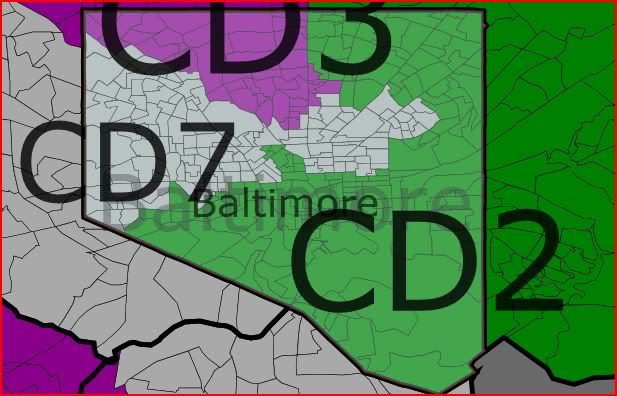
North of DC
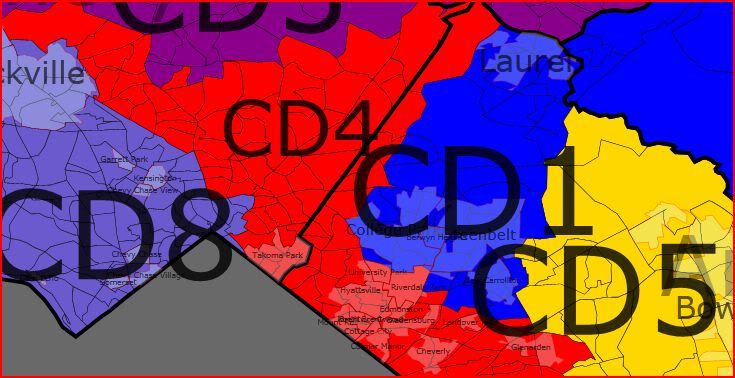
East of DC
